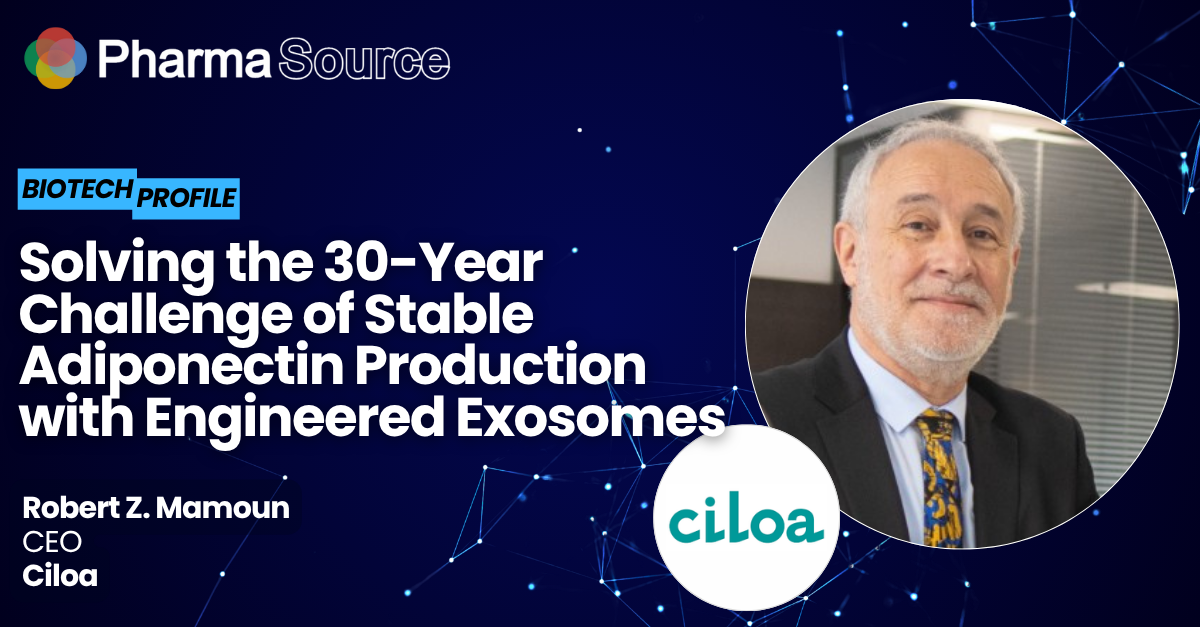French biotech Ciloa outlines how 14 years of exosome engineering trials led to breakthrough adiponectin biotherapeutic now advancing toward Phase I trials in 2027. CEO Robert Z. Mamoun describes the transition from retrovirus research to developing what the company claims is “the most efficient technology in the world” for bioengineering small extracellular vesicles with therapeutic proteins.
From Retrovirus Research to Therapeutic Breakthrough
Ciloa emerged from an unexpected discovery at Montpellier University in 2011. Co-founders Robert Z. Mamoun and Bernadette Trentin were investigating retroviruses when they identified a small viral peptide that could hijack small extracellular vesicle (sEV) machinery. This finding became the foundation for their proprietary technology that can bioengineer sEVs—also known as exosomes—with any type of protein loaded onto or into them.
The Montpellier-based company has now developed this platform into what it positions as the world’s most versatile exosome engineering technology, with a pipeline of 130 different proteins successfully integrated with sEVs. Their lead program targets the long-standing challenge of producing stable, functional recombinant adiponectin for metabolic disease treatment, specifically type 2 diabetes and obesity.
With €6.5 million in recent funding from France’s Innovation in Biotherapies and Biomanufacturing initiative, Ciloa is preparing to advance their adiponectin-sEV (APN-sEV) candidate into Phase I trials by 2027, followed by Phase IIa studies in 2028.
Solving the Adiponectin Production Challenge
Adiponectin has represented a significant manufacturing hurdle for the biopharmaceutical industry for three decades. The protein’s instability and loss of function during recombinant production has prevented successful therapeutic development despite its clear therapeutic potential for metabolic diseases.
Ciloa’s approach addresses this challenge by engineering the protein directly onto small extracellular vesicles, maintaining both stability and biological function. “Using this technology, Ciloa overcame the 30-year challenge of producing stable, functional recombinant adiponectin, enabling the development of a promising new biotherapeutic,” explains CEO Mamoun.
The company’s broader platform demonstrates remarkable versatility, with successful protein loading across diverse therapeutic targets. Beyond their lead adiponectin program, Ciloa has developed a pipeline of 10 candidate vaccines based on sEVs for various applications, leveraging their original discovery of viral antigen presentation technology.
Manufacturing Strategy: From Academic Labs to GMP Production
Ciloa’s manufacturing approach reflects careful planning developed over 14 years of process optimization. The company has systematically addressed each production challenge, from upstream cell culture to downstream purification and quality control.
“Thanks to 14 years of trials, with failures and successes, all the CMC challenges have been solved, resulting in a reliable and robust process,” notes Mamoun. The team has precisely defined critical parameters including cell lines, culture medium composition, cell support systems, harvest timing, purification processes, and comprehensive quality criteria for sEV number, identity, integrity, and protein loading.
A key manufacturing milestone was successfully transitioning from cell factories to fixed-bed bioreactors without compromising product quality. This scale-up achievement enables the increased production volumes needed for clinical supply while maintaining the exacting standards required for their complex sEV-protein constructs.
The company’s current manufacturing timeline involves transferring their optimized process to their in-house clean room facility for initial scale-up, followed by technology transfer to a shared manufacturing organization (SMO) GMP facility for clinical batch production in 2027. This staged approach allows Ciloa to maintain process control while accessing specialized GMP capabilities.
One notable operational achievement is product stability—their engineered sEVs remain functional for over one year when refrigerated, providing significant advantages for storage, distribution, and clinical trial logistics compared to conventional protein therapeutics.
Strategic Development Timeline and Regulatory Path
Ciloa’s development strategy balances scientific rigor with practical manufacturing considerations. Their immediate focus centers on completing standard operating procedures for their first engineering batch of APN-sEVs within 12 months, followed by IND application preparation with their initial GMP batch by the end of 2026.
This timeline reflects the company’s methodical approach to clinical transition. Rather than rushing to clinical trials, they have invested substantial time in process development and manufacturing optimization—an approach that may reduce later-stage development risks.
The company has raised more than €15 million in dilutive and non-dilutive funding to support this development pathway, providing runway for their planned clinical entry and early-stage trials.
Operational Transformation: From R&D to Drug Development
Mamoun emphasizes the fundamental shift required when transitioning from research-focused operations to drug development. “Transitioning from an R&D company to one that produces drug candidates requires a complete change in philosophy and practice. This involves training all staff to implement procedures and ensure traceability.”
This transformation extends beyond technical processes to organizational culture and capabilities. The company has systematically recruited specialized expertise and established comprehensive documentation systems required for regulated drug manufacturing.
Their experience highlights a critical challenge facing many academic spin-offs: successfully bridging the gap between promising research discoveries and commercially viable drug development operations.
Lessons for Emerging Biotechs
For fellow biotech founders navigating similar transitions, Mamoun offers practical guidance based on Ciloa’s experience: “Carefully consider the various possible development plans and their financial implications. Most importantly, surround yourself with the right people who have the necessary expertise.”
The company’s development path illustrates the value of thorough process development before clinical entry. Their 14-year investment in understanding and optimizing sEV production has created a robust platform that may support multiple therapeutic programs.
Ciloa also benefited from strong regional support networks, particularly Medvalley association and the BIC Business Innovation Center in Montpellier, which provided essential business development training and ongoing advisory support throughout their evolution from university spin-off to clinical-stage biotech.
As Mamoun concluded, “It’s also essential to recruit the right expertise and seek advice at every stage, even before you get started.”







